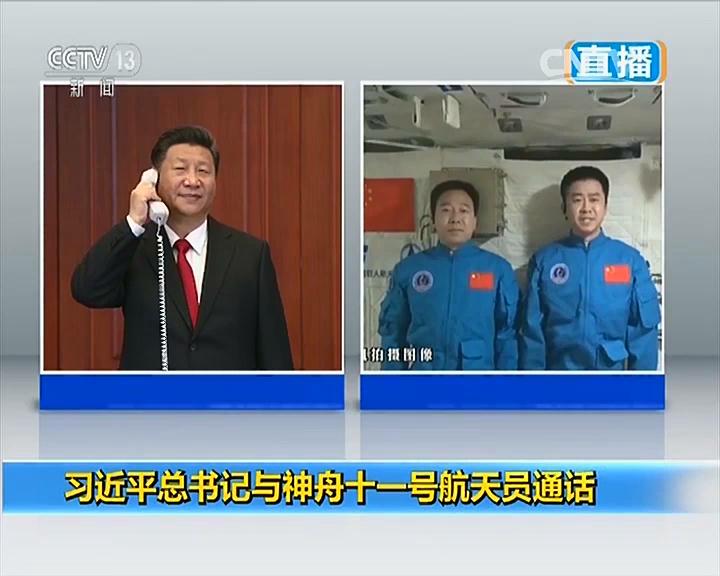
China's Tiangong-2 Space Lab Crew Tests Robot Tech

China's ongoing piloted space mission is rounding the corner on a month-long mission, with two crewmen living onboard the country's Tiangong-2 space lab.
The 49-year-old Jing Haipeng and 37-year-old Chen Dong launched into the space on their Shenzhou-11 mission on Oct. 17, docking with the Tiangong-2 two days later. [China's Tiangong-2 Space Lab Explained (Infographic)]

Experiments underway
Wu Dawei, director, overall plan office, Beijing Aerospace Flight and Control Center reports on a CCTV-Plus interview: "The astronauts are in excellent shape. They have completely adapted to the space environment after going through the initial period in the space. They now eat well, sleep well, and work well. As for food, they are very pleased with the food this time. They sleep very well, about seven hours daily. That's their current condition."
Wu said that the experiments onboard Tiangong-2 are proceeding as planned, and the space duo have finished about nine or ten of them. "The remaining ten plus experiments will be finished in the coming week."
Presidential call
General Secretary of the Communist Party of China (CPC) Central Committee Xi Jinping — also Chinese president and chairman of the Central Military Commission — called the two astronauts aboard the Tiangong-2 space lab from the command center of China's manned space program on Wednesday.
Before making the call, Xi watched the brain-computer interaction in-orbit repair experiment on Tiangong-2 at the Command Center.
Arm work
Reports CCTV-Plus, the Tiangong-2 space lab is equipped with an in-orbit repair robotic arm terminal operation system, which is used by astronauts to test the brain-computer interaction in-orbit repair technology that will allow astronauts to control equipment with their thoughts rather than manually.
Get the Space.com Newsletter
Breaking space news, the latest updates on rocket launches, skywatching events and more!
The system, over 4 feet long (1.35 meters) includes the human-simulated robotic arm, human-simulated robotic hand, binocular global camera, hand-eye camera, controller, data glove and three-dimensional mouse.
The size of the human-simulated robotic hand conforms to the size of the hand of the astronauts in extravehicular spacesuit.
Robotic servicing
Billed as the first such experiment in the world, it was jointly developed by the fifth institute of the China Aerospace Science and Technology Corporation (CASC), the Harbin Institute of Technology, and the Beijing Institute of Technology.
The experiment verifies the in-orbit technology of the core parts of the robotic arm, exploring the brain-computer interaction mode to accumulate experience of space robots working in orbit.
During the experiment, the robotic hand will simulate the typical moves of dismantling the thermal insulation materials, unscrewing the electric plug, and using electric tools to turn the screws in the orbit.
Other tests include robotic joint stiffness in-orbit identification and grasping floating balls, reports CCTV-Plus.
Lettuce, silkworms
As of today (Nov. 12), astronauts Jing and Chen have been onboard the space lab for 25 days.
During their stay, the space travelers have carried out experiments like planting nine lettuce plants and raising silkworms, in addition to in-orbit maintenance of spacecraft.
Jing and Chen are expected to stay in the space for 33 days. They work six days a week in line with schedules on the ground during this longest piloted mission for China.
The astronauts have a menu with nearly one hundred dishes for their meals. Their menu changes every day for a 5-day period. They also can watch news programs, football games and documentaries in the space lab, a space lifestyle that includes an exercise program.
Leonard David is author of "Mars: Our Future on the Red Planet." The book is a companion to the National Geographic Channel six-part series coming in November. A longtime writer for Space.com, David has been reporting on the space industry for more than five decades. Follow us @Spacedotcom, Facebook or Google+.
Join our Space Forums to keep talking space on the latest missions, night sky and more! And if you have a news tip, correction or comment, let us know at: community@space.com.

Leonard David is an award-winning space journalist who has been reporting on space activities for more than 50 years. Currently writing as Space.com's Space Insider Columnist among his other projects, Leonard has authored numerous books on space exploration, Mars missions and more, with his latest being "Moon Rush: The New Space Race" published in 2019 by National Geographic. He also wrote "Mars: Our Future on the Red Planet" released in 2016 by National Geographic. Leonard has served as a correspondent for SpaceNews, Scientific American and Aerospace America for the AIAA. He has received many awards, including the first Ordway Award for Sustained Excellence in Spaceflight History in 2015 at the AAS Wernher von Braun Memorial Symposium. You can find out Leonard's latest project at his website and on Twitter.









